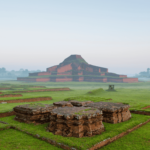Introduction:
Bangladesh is home to some of the most magnificent examples of Mughal architecture, especially its mosques. For history buffs, architecture enthusiasts, or travellers looking for a deeper cultural experience, these mosques offer an incredible glimpse into the country’s rich Islamic heritage. Whether you’re wandering through Dhaka or exploring the rural landscapes, Mughal-era mosques stand as testaments to the grandeur of the past. Did you know that some of these mosques have stood for over 300 years and still serve as active places of worship? Let’s dive into this traveller’s guide and discover the Mughal-era mosques of Bangladesh that you simply can’t miss!
What Defines Mughal-Era Mosques?
Mughal architecture is easily recognizable for its grandeur, and the mosques built during this era are no exception. These mosques typically feature large, elegant domes and towering minarets that leave a lasting impression on anyone who visits. The beauty lies in their intricate tilework, geometric patterns, and calligraphic inscriptions. One striking element of Mughal design is the careful symmetry in every structure. This balance, which is meant to symbolise harmony and divinity, extends from the arrangement of the pillars to the layout of the courtyards.
What makes these mosques unique is the blend of Persian, Islamic, and Indian architectural influences. The Mughals were masters at fusing styles, resulting in buildings that are both functional and visually breathtaking. Many mosques have large open courtyards surrounded by lush gardens—elements inspired by Persian design, representing paradise. Not only were these spaces used for prayer, but they also served as community gathering spots. Visiting these mosques today feels like walking through living history, a testament to the architectural skill and cultural pride of the Mughal Empire.
Your Attractive Heading
When you’re planning your visit, there are a few must-see mosques that will take you on a journey back in time:
- Ahsan Manzil Mosque (Dhaka): This small yet beautiful mosque is part of the grand Ahsan Manzil, also known as the Pink Palace. Although lesser-known compared to other mosques, its Mughal features make it worth a visit.
- Chhota Katra Mosque (Dhaka): Built within the Chhota Katra, one of Dhaka’s ancient caravanserais, this mosque showcases traditional Mughal elements with its dome and arches.
- Bibi Mariam Mosque (Dhaka): Located in Narinda, Bibi Mariam Mosque is one of the oldest examples of Mughal architecture in Bangladesh. Its elegant simplicity, adorned with brickwork and arches, reflects the aesthetic sensibilities of the Mughal period.
- Shat Gambuj Mosque (Bagerhat): A UNESCO World Heritage Site, this mosque is famous for its 60 domes. Built by Saint Khan Jahan Ali in the 15th century, it is one of the most impressive examples of early Islamic architecture in the country.
- Khan Mohammad Mridha Mosque (Old Dhaka): A picturesque example of symmetry and Mughal design, this mosque sits on a raised platform and features three domes. Its simple yet elegant design makes it a perfect stop for architecture enthusiasts.
Each of these mosques not only serves as a religious site but also tells the story of how the Mughal dynasty shaped the culture of Bangladesh.
The History Behind Bangladesh’s Mughal-Era Mosques
The Mughal Empire left a lasting impact on the Indian subcontinent, and Bangladesh was no exception. The construction of mosques during the Mughal period was seen as both a religious and political statement, with rulers using these structures to demonstrate their power and devotion to Islam. These mosques were often commissioned by Mughal emperors, provincial governors, or wealthy patrons who wished to leave behind a legacy.
During the Mughal rule from the 16th to 18th centuries, Bengal became a hub of Islamic culture and trade. The region’s prosperity allowed for the construction of many beautiful mosques, which were not only places of worship but also centres for learning and community gatherings. Each mosque carries its unique history—some were built to commemorate victories, others to honour saints or serve growing Muslim populations in newly conquered areas.
Architectural Highlights to Look For
One of the most mesmerising aspects of visiting Mughal-era mosques is the intricate detail that has gone into their construction. Here are a few features you should definitely keep an eye out for:
- Domes and Minarets: Central to any Mughal mosque, the domes are often flanked by minarets, which were used for the call to prayer. The domes’ sheer size is meant to inspire awe, drawing the eye upward towards the heavens.
- Terracotta and Brickwork: Unlike the stone-heavy Mughal structures in other parts of South Asia, mosques in Bangladesh often use brick and terracotta, which give the buildings a distinctive reddish hue. This local material makes them both unique and sturdy.
- Decorative Motifs: Look closely at the intricate carvings, calligraphy, and geometric patterns on the mosque walls. These designs are not just ornamental but also carry religious significance, representing the infinite nature of Allah.
- Courtyards and Ablution Pools: These open spaces are not just practical for worshippers but are also aesthetic features that add to the grandeur of the mosque. The courtyards are often beautifully landscaped, reflecting the Mughal love for gardens.
Practical Tips for Visiting Mughal-Era Mosques in Bangladesh
As a traveller, you’ll want to make sure your visit is respectful and enjoyable:
- Dress Modestly: Be sure to cover your arms, legs, and head (for women) when entering mosques. Wearing respectful attire will ensure you fit in and honor local customs.
- Plan Around Prayer Times: The mosques are active places of worship, so it’s best to avoid visiting during the main prayer times, especially Friday prayers. However, visiting just before or after prayers gives you a quieter experience.
- Photograph with Care: Some mosques allow photography, while others do not. Be respectful and ask for permission before taking photos inside or around mosques.
- Carry Essentials: It can get hot, especially if you’re touring outdoor areas. Bring a hat, sunscreen, and water, but remember to store these items appropriately when inside mosque grounds.
Planning Your Mughal Mosque Tour: Routes and Transportation
Bangladesh’s capital, Dhaka, serves as a great starting point for a Mughal mosque tour. Many of the mosques in Old Dhaka are within walking distance of each other, allowing you to explore the city’s historical district easily.
For example, you could start your morning at Ahsan Manzil, then make your way to Chhota Katra and Khan Mohammad Mridha Mosque, all within a few hours. From Dhaka, you can arrange a day trip to Bagerhat to visit the famous Shat Gambuj Mosque. Local buses, taxis, and rickshaws are convenient for getting around, but hiring a knowledgeable guide can enhance your experience, providing historical context and insight.
Conclusion
Exploring Bangladesh’s Mughal-era mosques is like stepping into a time machine that takes you back to the height of Islamic architecture in the region. Each mosque offers a unique insight into the country’s rich history and cultural diversity. From the towering domes of Shat Gambuj Mosque to the intricate designs of Bibi Mariam Mosque, every visit will leave you awestruck by the beauty and craftsmanship of these ancient structures. Make sure to take your time, respect the local customs, and immerse yourself in the spiritual serenity these mosques provide.
So, pack your bags and get ready to explore Bangladesh’s stunning Mughal mosques—you’ll be left in awe of these architectural masterpieces! Whether you’re a history buff, an architecture lover, or just a curious traveler, this cultural journey is one that you’ll never forget.







